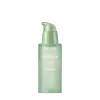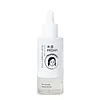What's inside
What's inside
 Key Ingredients
Key Ingredients

 Benefits
Benefits

 Concerns
Concerns

 Ingredients Side-by-side
Ingredients Side-by-side

Water
Skin ConditioningMethylpropanediol
SolventDipropylene Glycol
Humectant1,2-Hexanediol
Skin ConditioningGlycerin
HumectantGlycereth-26
HumectantAcrylates/C10-30 Alkyl Acrylate Crosspolymer
Emulsion StabilisingPPG-13-Decyltetradeceth-24
EmulsifyingTromethamine
BufferingAspergillus/Buckwheat Ferment Extract
AntioxidantCitric Acid
BufferingDisodium EDTA
Rosmarinus Officinalis Leaf Oil
MaskingButylene Glycol
HumectantAllantoin
Skin ConditioningEthylhexylglycerin
Skin ConditioningBetula Platyphylla Japonica Juice
Skin ConditioningMadecassoside
AntioxidantAsiaticoside
AntioxidantTocopherol
AntioxidantCentella Asiatica Extract
CleansingCornus Walteri Leaf Extract
Skin ConditioningMadecassic Acid
Skin ConditioningAsiatic Acid
Skin ConditioningWater, Methylpropanediol, Dipropylene Glycol, 1,2-Hexanediol, Glycerin, Glycereth-26, Acrylates/C10-30 Alkyl Acrylate Crosspolymer, PPG-13-Decyltetradeceth-24, Tromethamine, Aspergillus/Buckwheat Ferment Extract, Citric Acid, Disodium EDTA, Rosmarinus Officinalis Leaf Oil, Butylene Glycol, Allantoin, Ethylhexylglycerin, Betula Platyphylla Japonica Juice, Madecassoside, Asiaticoside, Tocopherol, Centella Asiatica Extract, Cornus Walteri Leaf Extract, Madecassic Acid, Asiatic Acid
Oryza Sativa Bran Water
MaskingGlycerin
HumectantButylene Glycol
HumectantPropanediol
Solvent1,2-Hexanediol
Skin ConditioningNiacinamide
SmoothingOryza Sativa Extract
AbsorbentEmbryo Extract
MoisturisingHeptasodium Hexacarboxymethyl Dipeptide-12
Skin ConditioningRice Sh-Oligopeptide-1
Skin ConditioningCuminum Cyminum Seed Extract
MaskingSh-Barley Seed Extract
Skin ConditioningGlycine Soja Seed Extract
Skin ConditioningSaccharum Officinarum Extract
MoisturisingRheum Officinale Stem Extract
Skin ConditioningCarya Ovata Bark Extract
Skin ConditioningOlivine Extract
Skin ConditioningPisum Sativum Extract
Skin ConditioningCoccinia Indica Fruit Extract
Skin ConditioningAzadirachta Indica Leaf Extract
Skin ConditioningBetaine
HumectantAllantoin
Skin ConditioningCeramide NP
Skin ConditioningCeramide Ns
Skin ConditioningCeramide AP
Skin ConditioningCeramide As
Skin ConditioningCeramide EOP
Skin ConditioningPhytosphingosine
Skin ConditioningCholesterol
EmollientAdenosine
Skin ConditioningDipotassium Glycyrrhizate
HumectantWater
Skin ConditioningSodium Polyacrylate
AbsorbentDisodium EDTA
Ethylhexylglycerin
Skin ConditioningCetearyl Alcohol
EmollientStearic Acid
CleansingHydrogenated Lecithin
EmulsifyingAcrylates/C10-30 Alkyl Acrylate Crosspolymer
Emulsion StabilisingArginine
MaskingOryza Sativa Bran Water, Glycerin, Butylene Glycol, Propanediol, 1,2-Hexanediol, Niacinamide, Oryza Sativa Extract, Embryo Extract, Heptasodium Hexacarboxymethyl Dipeptide-12, Rice Sh-Oligopeptide-1, Cuminum Cyminum Seed Extract, Sh-Barley Seed Extract, Glycine Soja Seed Extract, Saccharum Officinarum Extract, Rheum Officinale Stem Extract, Carya Ovata Bark Extract, Olivine Extract, Pisum Sativum Extract, Coccinia Indica Fruit Extract, Azadirachta Indica Leaf Extract, Betaine, Allantoin, Ceramide NP, Ceramide Ns, Ceramide AP, Ceramide As, Ceramide EOP, Phytosphingosine, Cholesterol, Adenosine, Dipotassium Glycyrrhizate, Water, Sodium Polyacrylate, Disodium EDTA, Ethylhexylglycerin, Cetearyl Alcohol, Stearic Acid, Hydrogenated Lecithin, Acrylates/C10-30 Alkyl Acrylate Crosspolymer, Arginine
 Reviews
Reviews

Ingredients Explained
These ingredients are found in both products.
Ingredients higher up in an ingredient list are typically present in a larger amount.
1,2-Hexanediol is a synthetic liquid and another multi-functional powerhouse.
It is a:
- Humectant, drawing moisture into the skin
- Emollient, helping to soften skin
- Solvent, dispersing and stabilizing formulas
- Preservative booster, enhancing the antimicrobial activity of other preservatives
Acrylates/C10-30 Alkyl Acrylate Crosspolymer is a synthetic polymer. It is used to thicken and improve the texture of products. Due to its properties, it can prevent water and oil ingredients from separating.
Allantoin is a soothing ingredient known for its protective and moisturizingg properties. Because of this, it is often added to products with strong active ingredients.
Studies show higher concentrations of this ingredient can promote wound healing.
Though it can be derived from the comfrey plant, allantoin is produced synthetically for cosmetic products to ensure purity.
Learn more about AllantoinButylene Glycol (or BG) is used within cosmetic products for a few different reasons:
Overall, Butylene Glycol is a safe and well-rounded ingredient that works well with other ingredients.
Though this ingredient works well with most skin types, some people with sensitive skin may experience a reaction such as allergic rashes, closed comedones, or itchiness.
Learn more about Butylene GlycolDisodium EDTA plays a role in making products more stable by aiding other preservatives.
It is a chelating agent, meaning it neutralizes metal ions that may be found in a product.
Disodium EDTA is a salt of edetic acid and is found to be safe in cosmetic ingredients.
Learn more about Disodium EDTAEthylhexylglycerin (we can't pronounce this either) is commonly used as a preservative and skin softener. It is derived from glyceryl.
You might see Ethylhexylglycerin often paired with other preservatives such as phenoxyethanol. Ethylhexylglycerin has been found to increase the effectiveness of these other preservatives.
Glycerin is already naturally found in your skin. It helps moisturize and protect your skin.
A study from 2016 found glycerin to be more effective as a humectant than AHAs and hyaluronic acid.
As a humectant, it helps the skin stay hydrated by pulling moisture to your skin. The low molecular weight of glycerin allows it to pull moisture into the deeper layers of your skin.
Hydrated skin improves your skin barrier; Your skin barrier helps protect against irritants and bacteria.
Glycerin has also been found to have antimicrobial and antiviral properties. Due to these properties, glycerin is often used in wound and burn treatments.
In cosmetics, glycerin is usually derived from plants such as soybean or palm. However, it can also be sourced from animals, such as tallow or animal fat.
This ingredient is organic, colorless, odorless, and non-toxic.
Glycerin is the name for this ingredient in American English. British English uses Glycerol/Glycerine.
Learn more about GlycerinWater. It's the most common cosmetic ingredient of all. You'll usually see it at the top of ingredient lists, meaning that it makes up the largest part of the product.
So why is it so popular? Water most often acts as a solvent - this means that it helps dissolve other ingredients into the formulation.
You'll also recognize water as that liquid we all need to stay alive. If you see this, drink a glass of water. Stay hydrated!
Learn more about Water